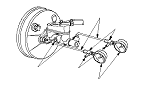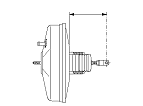Brake Booster Inspection
|
Special Tools Required
Pressure gauges set, 16,000 kPa
07YAJ-0010410
Combination gauge kit
07YAJ-0010610
Attachments
07410-5790102
Tube joint adapter
07410-5790503
Pressure gauge joint pipes, 10 x 1.0 mm
07510-6340101
Pressure gauge joint pipes, 12 x 1.0 mm
07HAK-SG00110
Leak Test
|
|
Booster Check Valve Test
|
|
Brake Assist Check (For KE, KG ABS models)
Make sure the brake assist is not activated early in case of installing brake booster and brake pedal. You may hear mechanical noises when pressing the brake pedal with some vacuum remained in brake booster. That could be caused in a normal condition, it would be not a symptom of abnormalities. The noises would not be created in the condition that the brake booster has no vacuum.
|
|
Brake Booster Pushrod Thickness (Reference)
NOTE: The illustration shows except KE, KG ABS models.
|
|||||||




